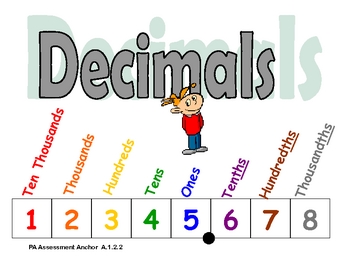
CCSS.MATH.CONTENT.6.NS.B.3
Fluently add, subtract, multiply, and divide multi-digit decimals using the standard algorithm for each operation.
Fluently add, subtract, multiply, and divide multi-digit decimals using the standard algorithm for each operation.
Today, we are taking a Pre-Assessment for our Decimals Unit, which will be used as an indicator for how the unit flows for each class. The Pre-Assessment is for checking understanding of addition, subtraction, multiplication, and division of decimals through computation, word problems, and real life applications.
Definition of Decimal
We sometimes say "decimal" when we mean anything to do with our numbering system, but a "Decimal Number" usually means there is a Decimal Point.
Large and Small
Our Decimal System lets us write numbers as large or as small as we want, using the decimal point. Digits can be placed to the left or right of a decimal point, to show values greater than one or less than one.
The decimal point is the most important part of a Decimal Number. Without it we are lost, and don't know what each position means.
23. 680
On the left of the decimal point is a whole number (such as 23). As we move further to the left, every place gets 10 times bigger!
The first digit on the right means tenths (1/10). As we move further to the right, every place gets 10 times smaller (one tenth as big)!





















